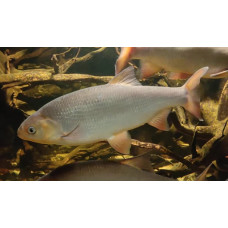Latin name
Leuciscus idus
Other name
Orfe
Identification
The body of the ide is thick. It is distinguished by the following features: a shortened head; a small, oblique mouth; 3.5-5.3 pharyngeal teeth; and a lateral line with 56-58 + 3 scales. Depending on the locality, age, or season, more or less distinct differences may be observed.
Features of fish fins
Dorsal spines (total): 3; Dorsal soft rays (total): 8 - 11; Anal spines: 3; Anal soft rays: 8 - 11.
These fish have 8½ branched rays in their dorsal fin, 10–11½ in their anal fin, and 19 in their caudal fin.
Fish colouring
In spring, Ide have a metallic luster. Their gill covers, or "cheeks," and heads seem golden. When they turn toward the sun, their colors change rapidly, acquiring golden, silver, and almost dark tones. Their lower fins, and sometimes their upper and caudal fins, are reddish. The back is bluish-black, the sides of the body are whitish, the belly is silver, and the caudal and dorsal fins are dark. The lower and lateral fins are red. The eyes are greenish-yellow or yellow with a dark spot on top. Young fish are distinctly lighter and more silvery with considerably paler fins than adult fish.
Distribution
It is more or less widespread in all European countries except southern and southeastern Europe (beginning in eastern France) and occurs in most of Siberia up to Yakutia. It inhabits the rivers of the Black Sea basin from the Danube to the Kuban (it is absent in Crimea) and the northern part of the Caspian basin in the Volga, Ural, and Emba rivers. It was introduced to North America and has become established in Connecticut in the United States.
Habitat
This is a freshwater fish that can also live in the brackish waters of sea bays. It is a benthopelagic, potamodromous species that prefers temperate climates. It inhabits depths ranging from 15 to 25 meters. It inhabits rivers, flowing lakes, and ponds. It avoids mountainous, fast-moving, and cold rivers.
Size
Adult fish typically grow to 35-53 cm in length and weigh 2-2.8 kg, though some can grow up to 90 cm long and weigh 6-8 kg. They live for 15 to 20 years.
Behavior
It prefers deep rivers with slow currents and a clayey, slightly silted bottom. It stays close to bridges, whirlpools, and pits below the rolls, as well as near banks with overhanging shrubbery. It is one of the hardiest fish and can easily endure sudden changes in temperature. It does not hibernate in the winter.
Adults are solitary, while juveniles are gregarious. It migrates to tributaries to spawn in moderate currents among gravel or underwater vegetation.
Food and feeding habits
These omnivorous fish feed on plant and animal matter, including insects and their larvae, mollusks, worms, and higher aquatic vegetation. They go to places with strong currents to feed. They feed at dusk and at night.
Reproduction
Spawning occurs during the second half of spring. Females spawn only once per season and spawn with several males. Males gather at spawning sites and follow the mature females. The adhesive eggs stick to gravel or submerged plants.
Fishing
It is the target of both commercial and recreational fishing.
Relationship with a person
Humans use this fish for food because of its relatively high flavor. Its flesh ranges in color from white to orange and is very bony. Without proper cooking, there is a risk of infection from opisthorchis larvae.
| Classification | |
| Phylum | Chordata |
| Class | Actinopterygii |
| Squad | Cypriniformes |
| Family | Leuciscidae |
| Genus | Leuciscus |
| Species | L. idus |
| Features | |
| Conservation status | Least Concern |
| Habitat | Pelagic |
| Life span, years | 20 |
| Maximum body weight, kg | 8 |
| Maximum length, cm | 90 |
| Sailing speed, m/s | No information |
| Threat to people | Edible |
| Way of eating | Predator |
Ide
Tags: ide



